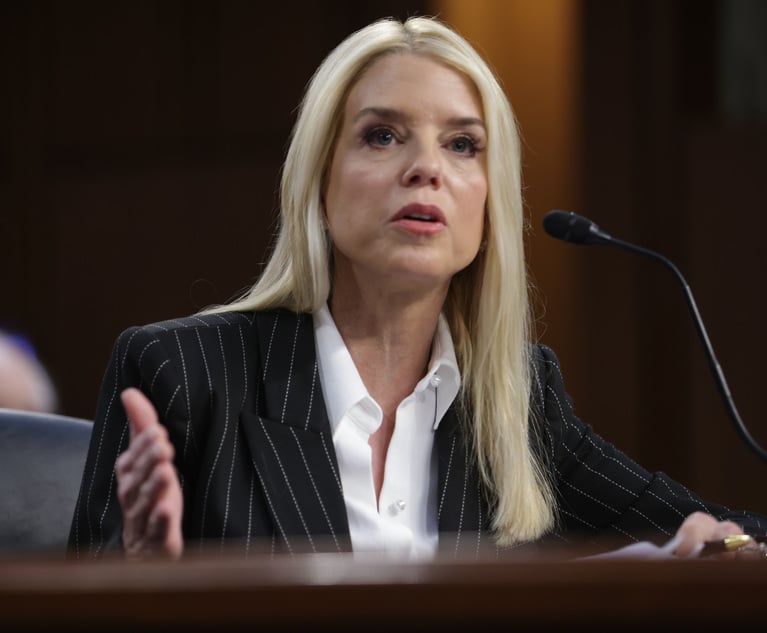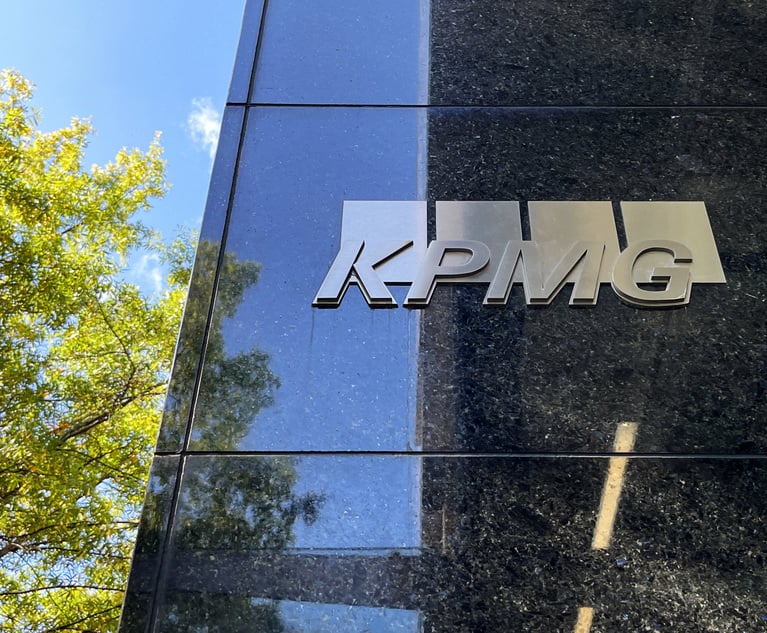Securities Class Action Filings Near Record High in 2018, Cornerstone Researchers Say
Cornerstone Research, which is based in San Francisco, found in its annual report that plaintiffs filed 403 new federal class action securities cases in 2018, down just 2 percent from a record high of 412 in 2017.
January 30, 2019 at 01:41 PM
3 minute read
 Photo: Rawpixel.com/Shutterstock.com
Photo: Rawpixel.com/Shutterstock.com
Securities class action filings remained at near record levels last year, as public companies faced a greater threat of being sued than in any previous year, according to a prominent report released on Wednesday.
Cornerstone Research, which is based in San Francisco, found in its annual report that plaintiffs filed 403 new federal class action securities cases in 2018, down just 2 percent from a record high of 412 in 2017. However, core filings—which do not include cases stemming from mergers and acquisitions—ticked up to a total of 221 last year, the study found.
According to the report, one in 11 companies on the S&P 500 was sued in 2018, with firms in the health care sector being the prime target of new core filings. About 4.5 percent of companies listed on U.S. exchanges were hit with core filings in 2018, marking the sixth consecutive year that firms' exposure to the claims had increased. Including M&A filings, a record 8.4 percent of U.S. exchange-listed companies were sued last year, the report found.
The findings followed another report from NERA Economic Consulting on Tuesday, which noted an increase in settlement values last year had coincided with an uptick in securities class action filings. NERA's report pegged the total number of filings at 441 for 2018, up slightly from the year before.
Cornerstone, which partnered with the Stanford Law School Securities Class Action Clearinghouse, found that the 403 federal securities class actions filed last year were the second-highest on record, trailing only 2017. The volume of core filings in 2018 was the highest since 2008, when the financial crisis hit and filings surged due to volatility in the U.S. and global financial markets, the report found.
Meanwhile, filings stemming from mergers and acquisitions decreased to 182 in 2018 from 198 the year prior, but still registered the second-highest total since Cornerstone began separately tracking core and M&A filings in 2009. The study found that the Delaware Court of Chancery's 2016 rejection of disclosure-only settlements in Trulia had resulted in more merger-objection lawsuits being filed in federal courts, with courts in the Second and Third Circuits fielding nearly half of all filings in 2018.
The Cornerstone review found that three law firms—The Rosen Law Firm and Pomerantz, both in New York, and Los Angeles-based Glancy Prongay & Murray—were driving the increase in core filings over the last six years, though their rate of appointment as lead or co-lead counsel had not changed in recent years.
In total, Rosen, Pomerantz and Glancy Prongay accounted for 54 percent of all core filings in 201, and were appointed lead counsel in a little more than 40 percent of all cases. They were typically picked to lead cases whose size were smaller than the national average, Cornerstone said.
The firms, however, were also responsible for more individuals being named as lead plaintiff in core securities filings, reversing a trend from 2004 to 2012 when large institutional investors were more likely to play that role, according to the report.
“Starting in 2013, individuals were appointed as lead plaintiff more often than institutional investors. This suggests a shift in litigation strategies by some plaintiff law firms,” it said.
NOT FOR REPRINT
© 2025 ALM Global, LLC, All Rights Reserved. Request academic re-use from www.copyright.com. All other uses, submit a request to [email protected]. For more information visit Asset & Logo Licensing.
You Might Like
View All

'Lack of Independence' or 'Tethered to the Law'? Witnesses Speak on Bondi
4 minute read
The Law Firm Disrupted: Tech Investment Is Necessary Yet Expensive. The Big Four Have a Leg Up
Trending Stories
- 1'A Death Sentence for TikTok'?: Litigators and Experts Weigh Impact of Potential Ban on Creators and Data Privacy
- 2Bribery Case Against Former Lt. Gov. Brian Benjamin Is Dropped
- 3‘Extremely Disturbing’: AI Firms Face Class Action by ‘Taskers’ Exposed to Traumatic Content
- 4State Appeals Court Revives BraunHagey Lawsuit Alleging $4.2M Unlawful Wire to China
- 5Invoking Trump, AG Bonta Reminds Lawyers of Duties to Noncitizens in Plea Dealing
Who Got The Work
J. Brugh Lower of Gibbons has entered an appearance for industrial equipment supplier Devco Corporation in a pending trademark infringement lawsuit. The suit, accusing the defendant of selling knock-off Graco products, was filed Dec. 18 in New Jersey District Court by Rivkin Radler on behalf of Graco Inc. and Graco Minnesota. The case, assigned to U.S. District Judge Zahid N. Quraishi, is 3:24-cv-11294, Graco Inc. et al v. Devco Corporation.
Who Got The Work
Rebecca Maller-Stein and Kent A. Yalowitz of Arnold & Porter Kaye Scholer have entered their appearances for Hanaco Venture Capital and its executives, Lior Prosor and David Frankel, in a pending securities lawsuit. The action, filed on Dec. 24 in New York Southern District Court by Zell, Aron & Co. on behalf of Goldeneye Advisors, accuses the defendants of negligently and fraudulently managing the plaintiff's $1 million investment. The case, assigned to U.S. District Judge Vernon S. Broderick, is 1:24-cv-09918, Goldeneye Advisors, LLC v. Hanaco Venture Capital, Ltd. et al.
Who Got The Work
Attorneys from A&O Shearman has stepped in as defense counsel for Toronto-Dominion Bank and other defendants in a pending securities class action. The suit, filed Dec. 11 in New York Southern District Court by Bleichmar Fonti & Auld, accuses the defendants of concealing the bank's 'pervasive' deficiencies in regards to its compliance with the Bank Secrecy Act and the quality of its anti-money laundering controls. The case, assigned to U.S. District Judge Arun Subramanian, is 1:24-cv-09445, Gonzalez v. The Toronto-Dominion Bank et al.
Who Got The Work
Crown Castle International, a Pennsylvania company providing shared communications infrastructure, has turned to Luke D. Wolf of Gordon Rees Scully Mansukhani to fend off a pending breach-of-contract lawsuit. The court action, filed Nov. 25 in Michigan Eastern District Court by Hooper Hathaway PC on behalf of The Town Residences LLC, accuses Crown Castle of failing to transfer approximately $30,000 in utility payments from T-Mobile in breach of a roof-top lease and assignment agreement. The case, assigned to U.S. District Judge Susan K. Declercq, is 2:24-cv-13131, The Town Residences LLC v. T-Mobile US, Inc. et al.
Who Got The Work
Wilfred P. Coronato and Daniel M. Schwartz of McCarter & English have stepped in as defense counsel to Electrolux Home Products Inc. in a pending product liability lawsuit. The court action, filed Nov. 26 in New York Eastern District Court by Poulos Lopiccolo PC and Nagel Rice LLP on behalf of David Stern, alleges that the defendant's refrigerators’ drawers and shelving repeatedly break and fall apart within months after purchase. The case, assigned to U.S. District Judge Joan M. Azrack, is 2:24-cv-08204, Stern v. Electrolux Home Products, Inc.
Featured Firms
Law Offices of Gary Martin Hays & Associates, P.C.
(470) 294-1674
Law Offices of Mark E. Salomone
(857) 444-6468
Smith & Hassler
(713) 739-1250









